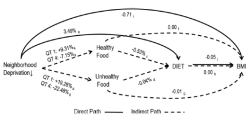Food vendors, neighborhood deprivation, and BMI
 Saturday, April 11, 2015 at 8:42AM
Saturday, April 11, 2015 at 8:42AM Zhang, YT, BA Laraia, MS Mujahid, A Tamayo, SD Blanchard, EM Warton, NM Kelly, HH Moffet, D Schillinger, N Adler, and AJ Karter. 2015. Does food vendor density mediate the association between neighborhood deprivation and BMI?: A G-computation mediation analysis. Epidemiology 26(3):344-352
 In previous research, neighborhood deprivation was positively associated with body mass index (BMI) among adults with diabetes. We assessed whether the association between neighborhood deprivation and BMI is attributable, in part, to geographic variation in the availability of healthful and unhealthful food vendors. Subjects were 16,634 participants of the Diabetes Study of Northern California, a multiethnic cohort of adults living with diabetes. Neighborhood deprivation and healthful (supermarket and produce) and unhealthful (fast food outlets and convenience stores) food vendor kernel density were calculated at each participant's residential block centroid. We estimated the total effect, controlled direct effect, natural direct effect, and natural indirect effect of neighborhood deprivation on BMI. Mediation effects were estimated using G-computation, a maximum likelihood substitution estimator of the G-formula that allows for complex data relations such as multiple mediators and sequential causal pathways. We estimated that if neighborhood deprivation was reduced from the most deprived to the least deprived quartile, average BMI would change by -0.73 units (95% confidence interval: -1.05, -0.32); however, we did not detect evidence of mediation by food vendor density. In contrast to previous findings, a simulated reduction in neighborhood deprivation from the most deprived to the least deprived quartile was associated with dramatic declines in both healthful and unhealthful food vendor density. Availability of food vendors, both healthful and unhealthful, did not appear to explain the association between neighborhood deprivation and BMI in this population of adults with diabetes. Journal link.
In previous research, neighborhood deprivation was positively associated with body mass index (BMI) among adults with diabetes. We assessed whether the association between neighborhood deprivation and BMI is attributable, in part, to geographic variation in the availability of healthful and unhealthful food vendors. Subjects were 16,634 participants of the Diabetes Study of Northern California, a multiethnic cohort of adults living with diabetes. Neighborhood deprivation and healthful (supermarket and produce) and unhealthful (fast food outlets and convenience stores) food vendor kernel density were calculated at each participant's residential block centroid. We estimated the total effect, controlled direct effect, natural direct effect, and natural indirect effect of neighborhood deprivation on BMI. Mediation effects were estimated using G-computation, a maximum likelihood substitution estimator of the G-formula that allows for complex data relations such as multiple mediators and sequential causal pathways. We estimated that if neighborhood deprivation was reduced from the most deprived to the least deprived quartile, average BMI would change by -0.73 units (95% confidence interval: -1.05, -0.32); however, we did not detect evidence of mediation by food vendor density. In contrast to previous findings, a simulated reduction in neighborhood deprivation from the most deprived to the least deprived quartile was associated with dramatic declines in both healthful and unhealthful food vendor density. Availability of food vendors, both healthful and unhealthful, did not appear to explain the association between neighborhood deprivation and BMI in this population of adults with diabetes. Journal link.
